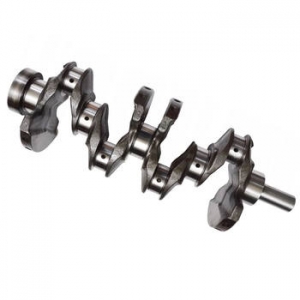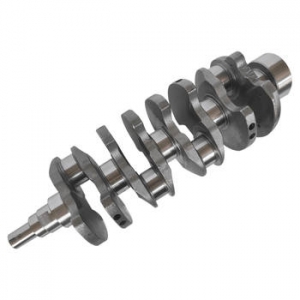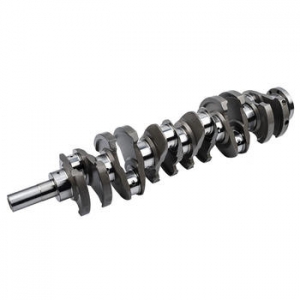The crankshaft, the backbone of any reciprocating engine, converts linear motion into rotary motion. But this conversion isn't without its challenges. Understanding the stress points within a crankshaft and its subsequent fatigue life is absolutely critical for ensuring engine reliability and longevity. Frankly speaking, if you ignore these factors, you're practically inviting premature engine failure. Have you ever wondered why some engines last hundreds of thousands of miles while others fail prematurely? Often, the answer lies in the crankshaft’s ability to withstand the immense stresses it endures.
Identifying Crankshaft Stress Points
Pinpointing the exact locations of maximum stress concentration is the first step in any fatigue life analysis. Several areas on a crankshaft are particularly susceptible to high stress. The fillet radii, where the crankpins and main journals blend into the webs, are prime examples. These sharp transitions act as stress raisers, meaning the stress experienced at these points is significantly higher than the nominal stress in the surrounding material. Similarly, oil holes drilled for lubrication, while essential, also introduce stress concentrations. The keyway slots, if present for timing gears or vibration dampers, are another common location for stress initiation. Finally, the connecting rod journals and main bearing journals themselves experience significant cyclic loading, contributing to fatigue. In my experience, a thorough understanding of these geometrical features is essential for accurate stress modeling.
Types of Stress Acting on a Crankshaft
A crankshaft experiences a complex combination of stresses during engine operation. Bending stress arises from the forces exerted by the connecting rods during combustion. Torsional stress results from the torque transmitted along the crankshaft to the engine output shaft. Tensile and compressive stresses are present due to the fluctuating gas pressure and inertial forces. It's worth noting that these stresses are not static; they are constantly varying in magnitude and direction with each engine cycle. This cyclic loading is what ultimately leads to fatigue failure. A crankshaft in a high-performance engine endures an even more aggressive stress profile compared to a commuter car.
Fatigue Life Prediction Methodologies
Predicting the fatigue life of a crankshaft is a complex engineering challenge, often involving sophisticated simulation tools and material testing. Several approaches exist, ranging from simplified empirical methods to advanced finite element analysis (FEA). Empirical methods rely on historical data and experimentally derived S-N curves (stress vs. number of cycles to failure) for the crankshaft material. FEA, on the other hand, allows for detailed stress analysis, taking into account the crankshaft's geometry, loading conditions, and material properties. FEA results are then used in conjunction with fatigue models to predict the component's life. Interestingly enough, the accuracy of these predictions heavily depends on the quality of the input data and the sophistication of the fatigue model used.
Material Selection and Heat Treatment
The material used in crankshaft construction plays a pivotal role in its fatigue resistance. High-strength steels, often alloyed with chromium, nickel, and molybdenum, are commonly employed. These alloys offer excellent fatigue strength and toughness. Cast iron crankshafts, while less expensive, are generally limited to lower-performance applications due to their lower tensile strength. The heat treatment process is equally important. Processes like carburizing, nitriding, and induction hardening are used to create a hard, wear-resistant surface layer that enhances fatigue life. These surface treatments introduce compressive residual stresses, which counteract tensile stresses and inhibit crack initiation. The proper selection and treatment of materials are essential for achieving the desired fatigue performance.
Surface Finish and Manufacturing Processes
The surface finish of a crankshaft can significantly influence its fatigue life. Rough surfaces create stress concentrations and act as potential crack initiation sites. Therefore, crankshaft journals and fillets are typically ground and polished to a very fine finish. Manufacturing processes, such as forging and machining, must be carefully controlled to minimize residual stresses and surface defects. Forging offers superior grain flow, which enhances fatigue strength compared to casting. Machining operations, if not properly executed, can introduce detrimental tensile residual stresses. Many experts agree that paying close attention to surface finish and manufacturing processes is crucial for maximizing fatigue life.
Practical Applications and Examples
The principles of crankshaft stress analysis and fatigue life prediction are widely applied in the automotive, aerospace, and marine industries. In the automotive sector, engineers use these techniques to design crankshafts that can withstand the demanding conditions of high-performance engines. In the aerospace industry, lightweight and high-strength crankshafts are essential for achieving optimal power-to-weight ratios. In the marine industry, crankshafts must be designed to withstand prolonged exposure to corrosive environments. Consider, for instance, the design of a Formula 1 engine crankshaft, where extreme performance and reliability are paramount. Every aspect, from material selection to surface finish, is meticulously optimized to ensure it can endure incredibly high stress levels. Why is this approach so effective? Because it combines advanced analysis with stringent quality control.
Monitoring and Diagnostics
While robust design and manufacturing are essential, monitoring and diagnostics can provide valuable insights into the health of a crankshaft during its service life. Vibration analysis, oil analysis, and non-destructive testing techniques can be used to detect early signs of fatigue damage. Vibration analysis can identify abnormal frequencies indicative of crankshaft imbalance or bearing wear. Oil analysis can reveal the presence of wear debris, providing clues about potential fatigue crack initiation. Non-destructive testing methods, such as ultrasonic testing and magnetic particle inspection, can detect surface and subsurface cracks. Early detection allows for timely maintenance or replacement, preventing catastrophic engine failure. Furthermore, data gathered from monitoring can be used to refine fatigue life prediction models and improve future designs.
Our Solutions for Crankshaft Durability
Our company offers advanced simulation and analysis services to help engineers design and optimize crankshafts for enhanced durability and fatigue life. We use state-of-the-art FEA software to accurately predict stress distributions under various loading conditions. Our expertise in fatigue modeling allows us to estimate the fatigue life of crankshafts, taking into account material properties, surface finish, and manufacturing processes. We also provide consulting services to help clients select appropriate materials, heat treatments, and manufacturing processes. We've found that a collaborative approach, combining our expertise with our clients' knowledge of their specific applications, yields the best results. Our goal is to help you design crankshafts that are not only high-performing but also reliable and long-lasting. To be honest, we strive to provide comprehensive solutions that address the entire product development lifecycle.
Conclusion: The Importance of Understanding Crankshaft Stress and Fatigue
Understanding crankshaft stress points and fatigue life is paramount for ensuring engine reliability and performance. From identifying critical stress locations to employing advanced fatigue prediction methodologies, a comprehensive approach is essential. By carefully considering material selection, manufacturing processes, and surface finish, engineers can design crankshafts that withstand the rigors of demanding applications. Furthermore, monitoring and diagnostics play a vital role in detecting early signs of fatigue damage and preventing catastrophic failures. Ultimately, a deep understanding of these principles translates to more durable, reliable, and efficient engines. This is why continued research and development in this area are so critical.
For more detailed information, please visit our official website: https://www.obfe.cn





